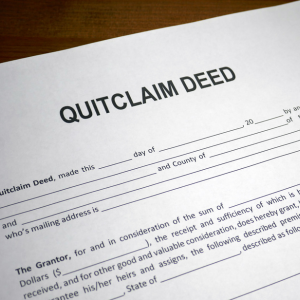
The Significance of Quitclaim Deeds in Real Estate Transactions
What is a quitclaim deed?
A quitclaim deed is a legal document that shows who owns a piece of land. Unlike other deeds, it doesn’t promise that the property’s ownership is correct. Instead, it gives away whatever interest the donor has at the time. People often engage in this act when they already trust each other, such as between family members.

When is a quitclaim deed typically used?
People often use quitclaim deeds to transfer ownership between family members. They help resolve title issues or property disputes by making ownership clear without much paperwork. A quitclaim deed can provide a quick solution in real estate transactions where checking the title’s history isn’t a priority. However, while it helps transfer ownership, it doesn’t protect against claims or liens on the property.
Key differences between quitclaim deeds and other property deeds
Understanding the differences among property deeds is essential for real estate transactions:
- Warranty Deed: This deed ensures the grantor possesses a valid title free of liens or encumbrances. It provides the highest level of protection, guaranteeing against potential future claims.
- Special Warranty Deed: This deed provides some warranty, ensuring the grantor hasn’t had title issues during their ownership. It offers more protection than a quitclaim deed but less than a warranty deed.
Each deed type serves different purposes in real estate. While quitclaim deeds allow quick ownership transfers, especially among families, they don’t assure title validity as warranty deeds do. It’s wise to consult a real estate expert for clear and marketable titles.
Steps to Prepare a Quitclaim Deed in California
How to Draft a Quitclaim Deed for Property Transfer
Drafting a quitclaim deed in California is an essential part of transferring property. Begin by getting a “quit claim deed template California” to follow state regulations. This template will help you learn how to prepare a quitclaim deed in California while meeting all the legal requirements. It is wise to have an attorney review these “legal requirements for a quitclaim deed in CA” to avoid mistakes. Ensure the deed has correct property information and meets local laws before filing it.

Necessary Information to Include in the Deed Document
For a valid quitclaim deed in California, include the following information:
- Grantor and Grantee: Name both parties involved in the transaction.
- Property Details: Provide a complete “legal description” of the property.
- Legal Requirements: Ensure they match California’s quitclaim deed standards.
These elements are necessary for the quitclaim deed to be legally effective.
How to Correctly Sign the Quitclaim Deed
The deed is valid only when appropriately signed. Here’s how to do it right:
- Notarization: The deed must be notarized to be legally valid. Locate a California-licensed “notary” to manage this matter.
- Signature: Both the grantor and any witness should sign the document in the notary’s presence.
- Execution: After notarization, the deed is ready to be filed with the county recorder’s office, completing the “execute quitclaim deed California” process.
These steps ensure the quitclaim deed is correctly prepared and ready for legal processing. For more help with real estate transactions, consult with Eazy House Sale, experts in simplifying property processes.
Filing and Recording Process for Quitclaim Deeds in California
Where to file a quitclaim deed in California
To file a quitclaim deed in California, you must visit the county recorder’s office where the property is located. Offices in counties like Los Angeles, Orange, San Diego, and Santa Clara can help with these filings. Knowing the correct filing location helps process the deed accurately.

How to ensure the deed is recorded correctly at the county recorder’s office
To record a quitclaim deed correctly at the county recorder’s office, follow these steps:
- Notarization: Get the quitclaim deed notarized in California to confirm the signatures are authentic.
- Verification: Double-check all details on the deed for any errors. The county recorder will verify the provided information.
- Submission: Submit the deed along with the required forms and fees, and keep copies for your records.
- Follow-Up: Regularly check with the county recorder to confirm they have recorded the deed.
Common mistakes to avoid during the filing process
Avoid these common mistakes to prevent delays or rejections when filing a quitclaim deed:
- Incorrect Information: Check all details, like names, addresses, and property descriptions, for accuracy.
- Fee Calculation Errors: Ensure fees are calculated correctly and paid in full, as errors here can cause delays.
- Omitting Additional Documentation: Confirm if the county requires additional documents, such as a preliminary change of ownership report.
By avoiding these errors, the quitclaim deed filing process can proceed smoothly, ensuring a legal and proper property transfer.
Legal and Financial Considerations of Quitclaim Deeds
Legal Implications of Using a Quitclaim Deed
A quitclaim deed is a formal document that lets someone else take over someone else’s property rights without guaranteeing the title. People often use it in family matters, divorce agreements, or short-term property moves. For a quitclaim deed to be legal in California, it must meet certain conditions:

- The grantor must sign the deed in front of a notary public.
- The seller must provide a clear description of the property.
- You need to record the deed with the county recorder’s office where the property is located.
Given its complexities, obtaining quitclaim deed legal advice in California from an attorney is recommended. Addressing risks like potential property disputes and ensuring proper documentation is essential for a quitclaim deed. An attorney can also guide you on contract and agreement formulations to protect your interests.
How Quitclaim Deeds Affect Property Taxes
Quitclaim deeds can make it easier to transfer land, but in California, they can change your property taxes. When you complete the transfer, the county may reevaluate the property’s tax situation, potentially increasing the taxes. Understanding the effects of the California quitclaim deed tax is essential, especially when planning your future. Talking to a property assessor can help you understand how the deed move will affect your taxes.
Financial planning also involves using quitclaim documents to change asset distribution. However, using them wrong could have tax effects you didn’t mean, so it’s essential to know how quitclaim rights and property taxes work together.
Understanding the Risks Associated with Quitclaim Deeds
Quitclaim deeds have risks that should be considered, especially in real estate transactions. Common risks include:
- Title errors can happen if the deed doesn’t convey the complete property interest or if there are existing liens.
- Lack of warranties: Unlike other deed types, a quitclaim deed does not guarantee a defect-free title, increasing the chance of property disputes.
- Insurance issues: Traditional title insurance may not cover issues from a quitclaim deed.
To avoid mistakes with quitclaim deeds in California, such as incorrect party listings or failing to record the deed, consult legal professionals specializing in real estate deed transfers in California. They help navigate legal risks and comply with state laws, reducing future problems and securing property rights effectively.
Quitclaim deeds have legal and financial implications for property transfers that demand careful thought and expert guidance. Eazy House Sale suggests consulting experienced professionals to ensure all processes meet California’s legal standards.
Alternatives and Additional Resources for Quitclaim Deeds
What are the alternatives to quitclaim deeds?
In California, knowing the different types of deeds is essential if you’re considering changing property ownership. Quitclaim deeds are quick for transferring interest but don’t offer a title warranty. Consider these alternatives:

- Warranty Deeds: These provide more protection. They ensure the grantor has a clear title. The deed also protects the grantee from any issues with the title during the grantor’s ownership.
- Grant Deeds: Like warranty deeds, they ensure the property hasn’t been sold to anyone else and provide certain warranties. They’re common in California real estate deals.
Understanding the legal steps for each deed type is key, especially for deed transfer in California. Talking to legal experts who know about real estate deed transfer can help you choose the best option.
How to find legal assistance for quitclaim deeds
Professional legal advice is crucial when dealing with quitclaim deeds or other real estate papers. Here are ways to find the right help:
- Attorney Referral Services: Utilize services that connect you with attorneys proficient in California’s quitclaim deeds. These services frequently evaluate lawyers for their proficiency in particular legal disciplines.
- Lawyer Referral Service: Contact local bar associations that can recommend attorneys familiar with property and title transfers in California.
- Consultation with Attorneys: Directly talk to attorneys experienced in real estate deals. They can offer specific quitclaim deed advice in California to help you understand property transfer rules.
Using these resources helps you grasp your legal options, ensuring you handle all necessary steps correctly.
Available resources for more information on quitclaim deeds in California
For more information on quitclaim deeds in California, check out these resources:
- California Deed Guidelines: Look at government documents and official publications that explain the state’s process and rules for deeds.
- County Recorder Office: Visit the local county recorder’s office for instructions on filing a quitclaim deed in California. They provide details on what documents you need and how to file them.
- Quitclaim Deed Form California: Find standard forms to prepare the deed correctly. Make sure each document meets the California quitclaim deed checklist to avoid mistakes.
These tools offer essential guidance, helping you manage quitclaim deeds efficiently. Stay organized, and you’ll smoothly handle the documentation for quitclaim deeds in California.
FAQs:
How do I file a quitclaim deed in California?
To file a quitclaim deed in California, prepare the deed with accurate property details and parties involved. Sign the deed before a notary and submit it to your local county recorder. Make sure to pay all required fees when you file.

What are the common mistakes to avoid when filing a quitclaim deed in California?
Avoid incorrect property or party details, not signing before a notary, and failing to record the deed with the county recorder’s office. Also, pay all necessary fees.
Can I file a quitclaim deed online in California?
You can prepare a quitclaim deed online through various legal service platforms, but you must file it physically at the county recorder’s office where the property is located.
Are there any specific costs associated with a quitclaim deed in California?
Yes, costs include notary, recording, and possibly service fees using an online platform. These fees can vary by county and service provider.
Is legal advice recommended when dealing with quitclaim deeds in California?
It’s advisable to seek legal counsel to ensure the process is done correctly and to address any concerns, especially regarding estate planning or avoiding disputes.

How does a quitclaim deed affect property ownership rights in California?
A quitclaim deed transfers ownership interest without warranties. It’s essential to understand that this type of deed carries risks, including possible disputes over ownership if improperly executed.
How can I access help for filing a quitclaim deed in Los Angeles?
For help, contact lawyer referral services or local legal aid organizations. Also, contact the Los Angeles County Recorder’s office for filing guidance.
What should I know before using a quitclaim deed for estate planning in California?
Understand that a quitclaim deed doesn’t guarantee a clear title. For complete estate planning, consult professionals to explore all options and implications.
Key Insights
- Filing a quitclaim deed in California involves navigating the county recorder’s office, understanding the fees, and completing the required documentation.
- To avoid common mistakes, focus on researching and planning the quitclaim deed process.
- You can find tailored legal advice by consulting a lawyer referral service in Los Angeles or any other city in California.
- Quitclaim deeds are useful for transferring property between relatives or resolving disputes with tenants or workers.
- Check the fee for each county recorder’s office to ensure smooth deed recording and avoid delays.
- Consider the potential risks and costs of quitclaim deeds in California, especially if banks are involved.
- Legal counsel might recommend using notaries or working with attorneys to prepare and clearly define the terms of the deed.
- Understanding local regulations, with examples from places like San Francisco, helps make informed decisions.
- Resources like Eazy House Sale offer insights and tools to facilitate smooth transactions, ensuring all parties consent and execute the deed properly.
- Despite changing laws, using quality resources such as assessor data or historical records can help ensure a successful property transfer.
This information applies to California and its cities, including Los Angeles, Long Beach, Norwalk, Inglewood, and Santa Monica, among many others. Please call us at (855) 915-1382 for assistance or if you have questions. You can also visit our website at Eazy House Sale for more details.


